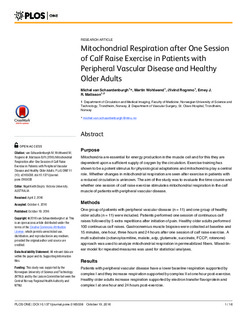| dc.contributor.author | van Schaardenburgh, Michel | |
| dc.contributor.author | Wohlwend, Martin Rainer | |
| dc.contributor.author | Rognmo, Øivind | |
| dc.contributor.author | Mattsson, Erney | |
| dc.date.accessioned | 2017-01-05T15:28:05Z | |
| dc.date.available | 2017-01-05T15:28:05Z | |
| dc.date.created | 2016-10-28T13:46:00Z | |
| dc.date.issued | 2016 | |
| dc.identifier.citation | PLoS ONE. 2016 | nb_NO |
| dc.identifier.issn | 1932-6203 | |
| dc.identifier.uri | http://hdl.handle.net/11250/2426511 | |
| dc.description.abstract | Purpose: Mitochondria are essential for energy production in the muscle cell and for this they are dependent upon a sufficient supply of oxygen by the circulation. Exercise training has shown to be a potent stimulus for physiological adaptations and mitochondria play a central role. Whether changes in mitochondrial respiration are seen after exercise in patients with a reduced circulation is unknown. The aim of the study was to evaluate the time course and whether one session of calf raise exercise stimulates mitochondrial respiration in the calf muscle of patients with peripheral vascular disease.
Methods: One group of patients with peripheral vascular disease (n = 11) and one group of healthy older adults (n = 11) were included. Patients performed one session of continuous calf raises followed by 5 extra repetitions after initiation of pain. Healthy older adults performed 100 continuous calf raises. Gastrocnemius muscle biopsies were collected at baseline and 15 minutes, one hour, three hours and 24 hours after one session of calf raise exercise. A multi substrate (octanoylcarnitine, malate, adp, glutamate, succinate, FCCP, rotenone) approach was used to analyze mitochondrial respiration in permeabilized fibers. Mixed-linear model for repeated measures was used for statistical analyses.
Results: Patients with peripheral vascular disease have a lower baseline respiration supported by complex I and they increase respiration supported by complex II at one hour post-exercise. Healthy older adults increase respiration supported by electron transfer flavoprotein and complex I at one hour and 24 hours post-exercise.
Conclusion:Our results indicate a shift towards mitochondrial respiration supported by complex II as being a pathophysiological component of peripheral vascular disease. Furthermore exercise stimulates mitochondrial respiration already after one session of calf raise exercise in patients with peripheral vascular disease and healthy older adults. | nb_NO |
| dc.language.iso | eng | nb_NO |
| dc.publisher | Public Library of Science | nb_NO |
| dc.rights | Navngivelse 4.0 Internasjonal | * |
| dc.rights.uri | http://creativecommons.org/licenses/by/4.0/deed.no | * |
| dc.title | Mitochondrial respiration after one session of calf raise exercise in patients with peripheral vascular disease and healthy older adults | nb_NO |
| dc.type | Journal article | nb_NO |
| dc.type | Peer reviewed | nb_NO |
| dc.source.volume | 11:e0165038 | nb_NO |
| dc.source.journal | PLoS ONE | nb_NO |
| dc.source.issue | 10 | nb_NO |
| dc.identifier.doi | 10.1371/journal.pone.0165038 | |
| dc.identifier.cristin | 1395410 | |
| dc.description.localcode | © 2016 van Schaardenburgh et al. This is an open access article distributed under the terms of the Creative Commons Attribution License, which permits unrestricted use, distribution, and reproduction in any medium, provided the original author and source are credited. | nb_NO |
| cristin.unitcode | 194,65,25,0 | |
| cristin.unitname | Institutt for sirkulasjon og bildediagnostikk | |
| cristin.ispublished | true | |
| cristin.fulltext | original | |
| cristin.qualitycode | 1 | |

